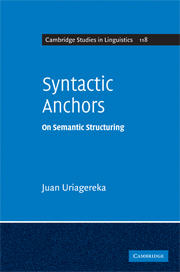Book contents
- Frontmatter
- Contents
- List of tables
- List of figures
- List of acronyms
- Introduction
- Acknowledgements
- 1 In defence of D-structure
- 2 So what's in a word?
- 3 Relational nouns, reference and grammatical relations
- 4 Online conditions and parametric variation
- 5 Prepositional case throughout
- 6 Iteration and related matters
- 7 (Re)Interpreting the Chomsky Hierarchy
- 8 Naturalizing meaning
- Epilogue: Evo-Devo-Perfo
- References
- Index
3 - Relational nouns, reference and grammatical relations
Published online by Cambridge University Press: 22 September 2009
- Frontmatter
- Contents
- List of tables
- List of figures
- List of acronyms
- Introduction
- Acknowledgements
- 1 In defence of D-structure
- 2 So what's in a word?
- 3 Relational nouns, reference and grammatical relations
- 4 Online conditions and parametric variation
- 5 Prepositional case throughout
- 6 Iteration and related matters
- 7 (Re)Interpreting the Chomsky Hierarchy
- 8 Naturalizing meaning
- Epilogue: Evo-Devo-Perfo
- References
- Index
Summary
Introduction
The previous chapter sketched some of the issues that arise in clarifying what may be a natural mapping of semantics from syntax. We studied lexical semantics and its component elements, specifically an ordering mechanism that was referred to as the part/whole-to-part/whole (P/W2) thesis. There are two sides to a mechanism of this sort. On one hand is the mapping itself, which this book argues ought to be as minimalistic as possible. On the other, for the presupposed co-linearity to obtain we have to understand what is meant by relevant structures mapped on each side – in this instance, Part/Whole (P/W) relations. Many researchers have devoted much thought to this concrete matter, especially because P/W relations manifest themselves in the guise of the interesting ‘possessive’ syntax (as in this whole has parts). Being concrete in characterizing such ‘possessive relations’ will help us ground the (multi-)dimensional syntax briefly alluded to in the previous chapter. Moreover, these relations are curious in that they provide a snapshot of the main thesis here: understanding the subtleties of possession requires both context-free relations of the conceptual sort and context-sensitive relations of the intentional sort. Indeed, the book will end up arguing that it is because of this dual nature of possession that we obtain dimensional shifts in the underlying syntax. Section 3.2 presents the basic problem posed by possessive expressions, and especially logically possible combinations that do not actually exist.
- Type
- Chapter
- Information
- Syntactic AnchorsOn Semantic Structuring, pp. 66 - 105Publisher: Cambridge University PressPrint publication year: 2008

